Skype Community Call: ‘Forest Fractal’ (Faye Yoshihara, Janice McDougall, Norbert Hoeller)
 Can biomimicry help us develop better business and organizational models? Faye Yoshihara hosted a Skype conference call on October 21st to discuss business models that support sustainable development. Janice McDougall added her perspectives on creating humane organizational structures that help promote sustainable businesses.
Can biomimicry help us develop better business and organizational models? Faye Yoshihara hosted a Skype conference call on October 21st to discuss business models that support sustainable development. Janice McDougall added her perspectives on creating humane organizational structures that help promote sustainable businesses.
The ultimate goal of taking a bio-inspired approach to business processes is to encourage more fundamental changes in the way businesses work rather than focusing only on their products or services. Faye’s experience suggests that some of her recent graduate students feel that the culture of large business is toxic, both in terms of personal impact and environmental consequences. The graduates feel limited in their options to work in environments that encourage new approaches to business.
Those of us on the call believe that biomimicry can help provide compelling and tangible business and organizational models to replace the current sports and military analogies. Rather than focusing on competition, efficiency and short-term profitability, biomimicry would suggest a greater emphasis on inter-dependence, effectiveness and resiliency.
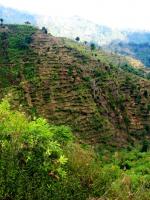
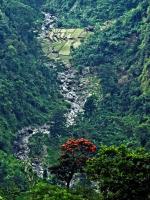 A better appreciation of the importance of natural systems can also lead to new business opportunities. Forest Fractal grew out of Faye’s interest in the ability of eco-tourism to support sustainable and restorative development. She has been developing business-to-business connections that generate increased sustainable livelihoods, such as an Indonesian project to replant a logged area. In addition to providing a local source of wood, the project introduced income-producing plants (including shade grown coffee and spices) that in turn increase biodiversity. The picture on the left shows degraded land on Mount Muria in North Central Java that is being restored by the Jepara Forest Conservancy, while the one on the right is an example of the ecological diversity and downstream water needs dependent on the project (photos from Indonesian Ecological Restoration & Education).
A better appreciation of the importance of natural systems can also lead to new business opportunities. Forest Fractal grew out of Faye’s interest in the ability of eco-tourism to support sustainable and restorative development. She has been developing business-to-business connections that generate increased sustainable livelihoods, such as an Indonesian project to replant a logged area. In addition to providing a local source of wood, the project introduced income-producing plants (including shade grown coffee and spices) that in turn increase biodiversity. The picture on the left shows degraded land on Mount Muria in North Central Java that is being restored by the Jepara Forest Conservancy, while the one on the right is an example of the ecological diversity and downstream water needs dependent on the project (photos from Indonesian Ecological Restoration & Education).
Faye has used a number of high level analogies from nature with her MBA and MFA (Masters of Fine Arts) students, such as temperate forest trophic levels. She has used watershed models to explore the connections between rural/urban and north/south. Lacking are more detailed operational models that could be applied to specific problems. Understanding the context and mapping to an analogy can be challenging – how should a business balance the global market (using analogies from migrating species) with a more local focus? Is a biologist on the team essential to effectively introduce bio-inspired design principles in discussions of organization design and structure?
The discussion touched on how concepts from biomimicry could best be introduced into business. Should concepts be incubated in the educational world or go through early testing in the real world? Should we focus on organizations in crisis or does that increase the risk of getting involved in ‘green-washing’? Is it possible to work from outside an organization or is it necessary to be fully embedded to be effective? Can changing organizational structures be an effective path to building better products and services? Although dealing with organizational structures and business models introduces significant complexity, this path may offer the best opportunity to advance beyond ‘going slower in the wrong direction’.
Skype Call Participant Perspectives
Faye: It was great to have a thoughtful dialogue about how to overcome the challenges we all face as we try to integrate bio-inspired strategies into the whole of business operations. I discovered colleagues are facing some of the same challenges that I’ve encountered and the format of the call allowed for us to gravitate to a rich discussion on topics of mutual interest. I even came out of the call with some new contacts, an unexpected but welcome bonus.
Janice: A key value of the call was connecting with someone who is farther along the "operationalization" scale than I, whose challenges are thus ‘next generation’. This gave me ideas on how to move my practice forward and to foresee what might be coming down the road. It also provided food for thought regarding how to most effectively introduce new methodologies of thinking and doing.
- Does the system have to be in "crisis" before room is made for the exploration of alternatives? What constitutes crisis may be unique to each organization, from a personal insight at the CEO level to an industry wide crisis in the case of extraction industries.
- How do we make the practice of biologically inspired design support other organizational goals rather than being an end in itself?
- Rather than looking for the "best place to start" (such as at the design level or at the organization level), should we follow the energy for change?
Norbert: Although both Faye and Janice felt product designers had an easier time of applying biomimicry, I believe the many of the problems they articulated apply across disciplines. Many designers want to help solve pressing problems but often feel limited in the amount of influence they can exert. All designers would benefit from models that go beyond inspiration to provide context-specific guidance on developing better solutions. As they deal with more complex problems, designers are increasingly called upon to balance economic, environmental and social requirements where direct analogies to nature are difficult to find. Ultimately, designers want their solutions to be widely used, which often means that many of the organizational issues addressed in the call need to be resolved.
Suggested Readings
- Restoration Development "takes advantage of positive synergies between ecological restoration and sustainable livelihoods ... to overcome the apparent conflicts between environmental conservation and economic development"
-

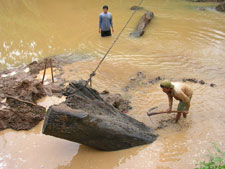 Tropical Salvage "create good, steady, eco-positive jobs ... protect the world's remaining primary tropical forests ... advocate for best responsible social and environmental practices". The pictures to the right show wood being salvaged from rivers and turned into fine furniture.
Tropical Salvage "create good, steady, eco-positive jobs ... protect the world's remaining primary tropical forests ... advocate for best responsible social and environmental practices". The pictures to the right show wood being salvaged from rivers and turned into fine furniture. - Forest Fractal Projects in Incubation are "an exploration of how art can interpret science in a manner that captures the imagination and motivates collective action on global issues such as climate change, invasive species, rural poverty & flight and land stewardship."
- Resilience Thinking: Sustaining Ecosystems and People in a Changing World (Brian Walker, David Salt) is a good resource for understanding how to manage human-ecological-industrial systems in a changing environment.
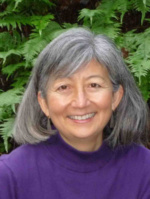
Faye Yoshihara specializes in brokering cross-sector partnerships and supporting start-up social enterprises. She recently launched Forest Fractal, LLC, a social enterprise dedicated to the restorative economy, working in forest biomes to support sustainable development.

Janice McDougall is a partner in Goodman, McDougall & Associates Ltd., a Human Resources consulting firm. She offers total rewards and facilitation consulting services in order to help clients make the work experience a great one for their staff, one that allows staff to meet their needs, fulfill the organization's goals and contribute to society.
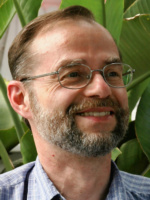
Norbert Hoeller is an independent researcher with a particular interest on the process of bio-inspired design. He is a director of BioDreamMachine and founded the Bio-Inspired Design Community.
